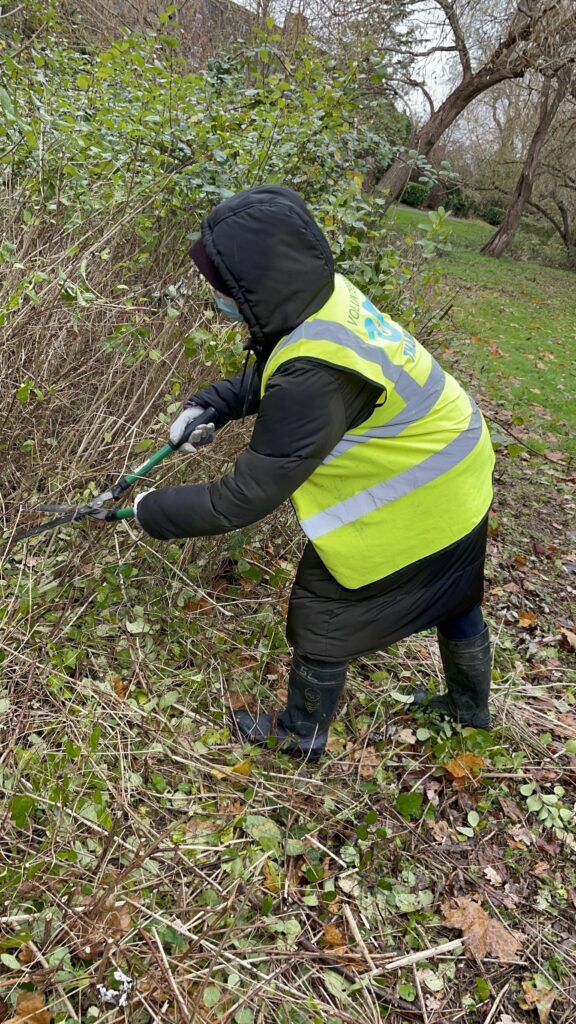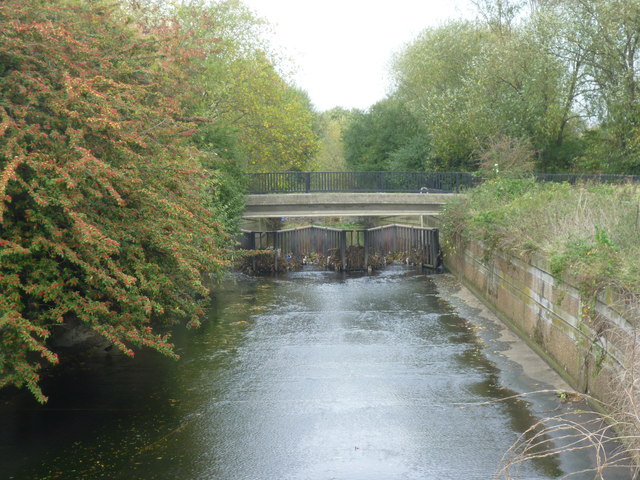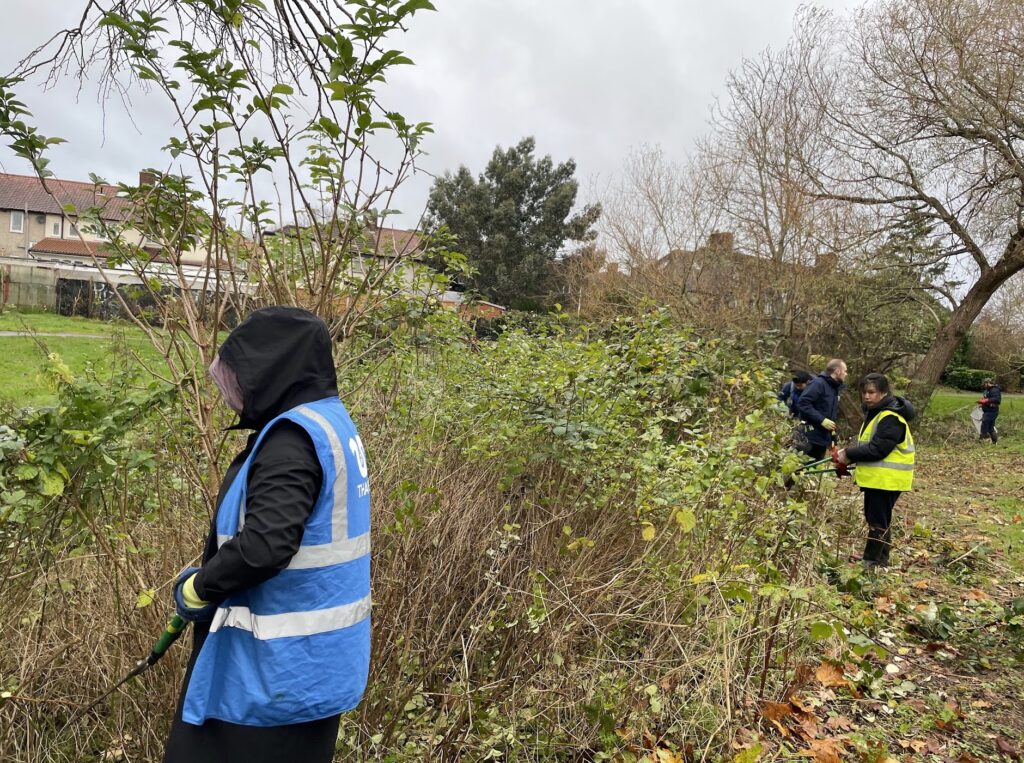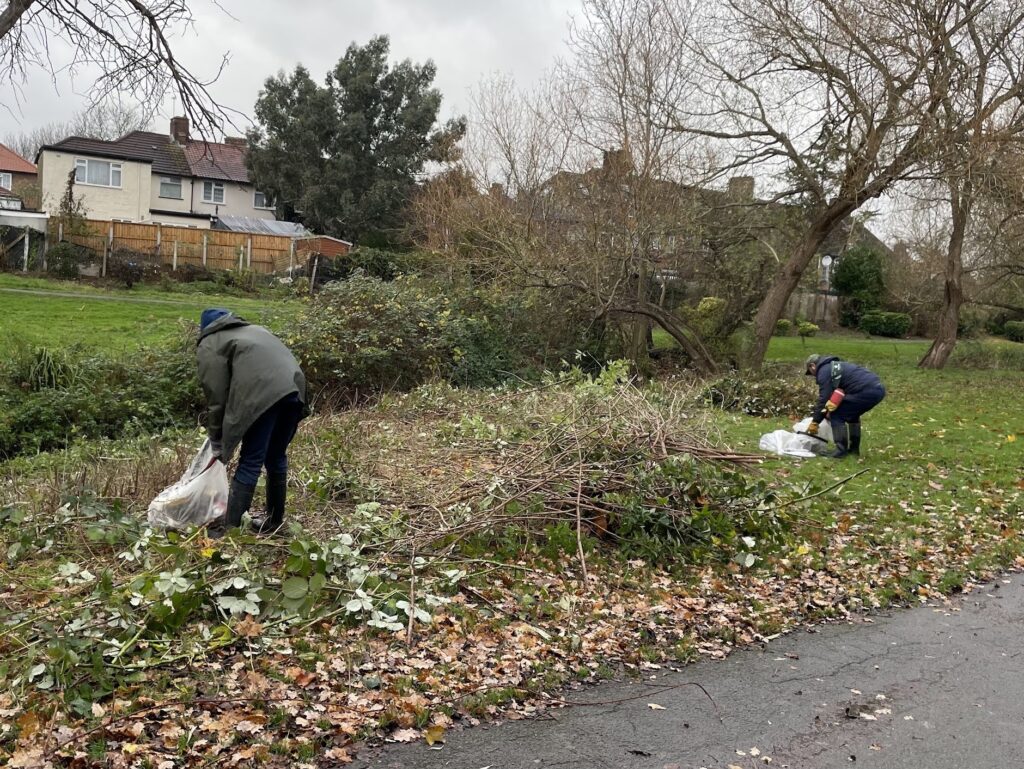Aisyah spent an afternoon tidying up London’s waterways and learned how a little effort can go a long way
The sun is nowhere to be found in Watling Park. There’s a constant drizzle of rain and I’m on a brookside, gardening shears in hand, suited and booted in PPE. A pair of steel toe cap wellingtons and two pairs of gloves to protect my feet and hands, the look is completed by a high-vis jacket lest my dark green jacket camouflages me within the shrubbery. I’m here to volunteer with Thames21, a London-based charity committed to the restoration of London’s waterways. Michael O’Neill, our 36-year-old supervisor, has instructed me and the other three volunteers to cut down the mess of overgrown vines and weeds. And off we went, haphazardly clipping at the brambles.

Image by: Thames21
Five minutes through, I had begun to appreciate the labour of gardeners working to maintain London’s green spaces. My forearms were aching, I could feel lesser-known muscles screaming for me to take a break. But I was on a mission to get to the other side of the bushes before my best friend, Rayhan, a 21-year-old biomedical science student at Kings College, who up till then claimed she was an ‘outdoorsy’ person, based purely on her love for walking through London’s parks. However, vegetation management was another ballpark for us city-dwellers.
Michael comes to check on us, every now and again, encouraging us and engaging with small talk about the weather. He tells us how before he got his gig with Thames21 he was builder who loved the outdoors and would regularly go out foraging for food. At which point, Rayhan’s interest piqued. “I was envious of Michael, it’s so nice that he can be so comfortable in nature” she tells me, mournful of what could have been if not for technology’s stranglehold over us.
On we continued, trimming, clipping, tearing our way through the overgrown stalks and vines. I lost count of how many times my coat got caught on the thorny vines.

Image by: Aisyah Muhamad Irfan
Back to Life
In a report published in November 2021, the Zoological Society of London reported that the River Thames was recovering from its 1957 “biologically dead” status. Despite this, the lesser-known River Brent, which flows through northwest and west London into the Thames, has had far fewer positive headlines. With recent reports of rubbish pileups in the Ealing stretch of the river, and rising pollution levels causing eels to gather together in pipes. This behaviour in eels may stem from the number of man-made weirs and sluices in the river. These barriers prevent the endangered European eel populations from making their way upstream to ample food sources.
The River Brent, like the island of Britain is thought to be named after the ancient Celtic Goddess, Brigantia. Prior to the opening of the Goring Gap, the River flowed through the River Thames’ current path. The river then became absorbed as part of the Thames, flowing through its current path from Dollis Brook in Hendon, moving south towards Greenford eventually emptying into the Thames in Brentford.
Since 2016, Thames21 has been on a mission to improve London’s waterways for the benefit of Londoners and the city’s local wildlife. In the case of the River Brent, the charity has been hosting several river clean-ups across the Brent catchment, encouraging people to come down to their local parks and volunteer with litter picking or vegetation management around the waterways.
As of 2021, the Brent catchment of waterways has been assessed to be of only ‘moderate’ ability to support local wildlife populations. By 2027, Thames21 hopes to improve the water quality to a ‘good’ level, meaning putting an end to the pollution affecting the waterways.

cc-by-sa/2.0 – © Marathon – geograph.org.uk/p/4216439
According to research done by Thames21 and Middlesex University, for the Greater London Assembly, the River Brent is one of the worst affected bodies of water by polluted road run-off. Run-off can carry over 300 pollutants, that cause short and long-term damage to waterways including killing fish and even turning water black. Other contributing sources of pollution for the Brent catchment come from bad plumbing; which affects arounds 8.3% of homes in the catchment, compared to a national average of 2%; industry; roads and railways; and overflowing sewage. As seen last summer during the summer floods, our sewage system is ill-equipped to deal with abundant rainfall. They are designed to overflow into the river system when there is too much rain. This issue is exacerbated when our sewers are blocked by fatbergs and non-flushable items.
Out of Sight
Clearing the Burnt Oak Brook is all part of Thames Water’s “Bin it – don’t block it” campaign. The brook, which feeds into the Silk Stream and in turn the River Brent, is in vital need of some TLC. As Michael explains, “Our river restoration projects involve removing brambles or trees that have overgrown the river and have strangled the river, slowing it down, and preventing people, animals and light from accessing the river.” In addition to vegetation management, Thames21 are also committed to natural flood management of the Silk Stream catchment. Building the area’s resilience to flooding while boosting biodiversity, river health and access to green space.
Michael mentions that Burnt Oak Brook used to be home to a community of water voles but as it stands now the brook has only managed to sustain schools of small fish.

Image by: Aisyah Muhamad Irfan

Image by: Aisyah Muhamad Irfan
Back at the brook, we’ve managed to completely remove the vegetation from our patch in just over two hours. Throughout the day, locals who were out walking their dogs through Watling Park make sure to let us know that they appreciate the efforts being put in to rehabilitate the park. The park around the brook is known to be a hotspot for anti-social behaviour in the evenings, making locals reluctant to use it. The other benefits of the vegetation management, as Michael informs us volunteers, is the improvement of sight lines through the park. The thick bushes we’ve removed were prime hideaways for people to participate in anti-social behaviour like drinking and taking drugs.
Gauging my own and other volunteers’ experiences volunteering with Thames21, the few hours we spent there clipping the bushes made for an incredibly fulfilling day. At a time when the climate crisis is on a lot of people’s minds, having the chance to contribute to making improvements to nature is gratifying. You should try it.
Are you interested in volunteering with Thames21?
Check out their website to see what activities are being held near you.
